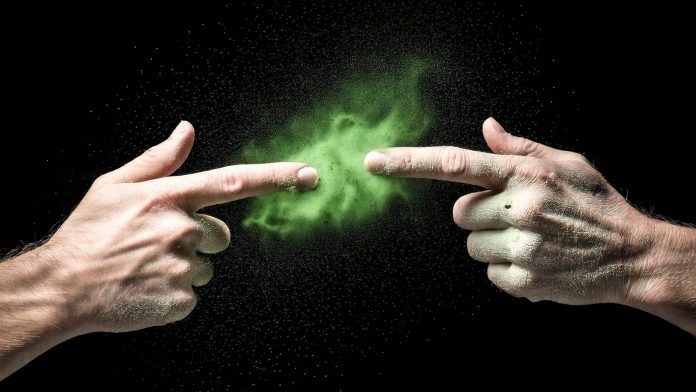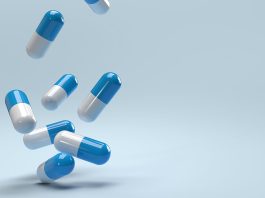Spectrum Blue considers the contamination of surfaces and the risk they pose for spreading infection.
You sneeze, breathe, sweat, and move bacteria all the time. So where do those viruses and bacteria end up and hide? Some microbes can hover in the air for days. Most of them land on surfaces, gather together, create a small colony, and create a biofilm. In this biofilm, the microbes can live for days and weeks, multiply and spread again. How can we reduce unwanted biofilm in housing?
A surfacing problem
Our body consists of trillions of bacteria and viruses. Actually, they outnumber the cells in your body! They are good for us and necessary for our wellbeing and good health. But a few ones, when they grow in number, are making us sick, cause infections or can even cause death. You know several family names by now: Noro, Covid, Salmonella, Streptococcus, Candida auris, Staphylococcus… and many more.
When viruses and bacteria enter a room or building, they can be spread by droplets (sneezing), breathing, or touch. Airborne versions stay in the air for a long time, bouncing into walls, ceilings, objects, and humans. Other, heavier versions land on surfaces more quickly. All of them can survive on a surface for a long time, depending on temperature, material, and humidity. If there is dirt, mould, or biofilm, the microbes can survive very long.
Viruses and bacteria hibernate, multiply, and spread through contaminated surfaces. This is a huge problem in all buildings, but especially hospitals and elderly homes, and it’s called Healthcare-Associated Infections, HAI.
Deaths and dollars
Healthcare-associated Infections (HAI) are infections that occur at the hospital, in an elderly home, at the dentist, or in other healthcare settings. These infections are increasingly resistant to antibiotics and are costing healthcare and society money.
One summary from 2022:

Airborne microbes
When the sun is low and shining through the windows into a room, you often see dust swirling around. If you lack dust to see, just remove your T-shirt or sweater in the sunlight, and you produce a million particles that you can easily see. These particles are gigantic in size compared to viruses and bacteria, but still, they hover around. The slightest difference in air temperature makes them rise upwards. Your own body temperature makes the air rise upwards against the roof before fluctuating down again.
After some time, the dust attaches to surfaces and is ‘invisible’.

Particles, microbes, and germs can drift around the room, sometimes bouncing off contaminated surfaces and finally settling everywhere. The obvious place is the floor and carpet; gravity influences even the smallest microbes, but targets include the walls and ceiling.

Source: Laurentiu Tacutu et al 2019 IOP Conf.
From surfaces to humans and back again
Humans touch surfaces and then spread germs. Surfaces that spread germs include door handles, handrails, furniture, medical equipment, TV controls, and even hand sanitiser (if it’s operated by your hand).

There are several YouTube videos that demonstrate this contagious phenomenon. Some of them are:
- Mark Rober “Seeing germs”
- Norwegian Institute for Public Health “The invisible challenge”
- Simulated virus spread in restaurants in Japan
So what can be done?
The obvious measures are hand sanitation and cleaning. The shortcomings of these good habits are that alcohol and antibac do not kill all germs, and many cleaning agents, such as chlorine, are dangerous for humans. The second and most important shortcoming is that this is instant treatment. The effect has a very short duration. The moment an unwanted microbe enters the site, the cleaning you did is just a nice welcome for the germ.

Face masks to protect yourself and others from your breath and saliva. Yes, but if you touch a surface with germs and then adjust your face mask, then your face mask has become a nice pitstop for germs. Some experts say that touching the face masks is a microbe heaven. And you can’t stop touching that, can you?
What about a solution that reduces microbes on surfaces 24/7, 365 days a year? That would be something. Can we protect surfaces so that microbes do not create biofilm and spread by being there in the next touch? Yes, we can.
That’s where Spectrum Blue’s Q-field enters the scene. Q-field is a photocatalytic pigment that is integrated into paint and textiles. It creates a quantum electric field that is harmless for humans and animals but creates a molecular electric fence for viruses, bacteria, and mould. It works 24/7, 365 days a year, and it just needs to be kept clean with water or micromops.

Imagine a room protected
Paint the walls and roof with a coating that repels biofilm. Coat touch-points. Integrate antimicrobials in furniture and curtains.

Imagine a building protected
Most rooms are painted, and the common areas include cantinas, toilets, doorknobs, and tabletops.
Please note, this article will also appear in the 20th edition of our quarterly publication.








